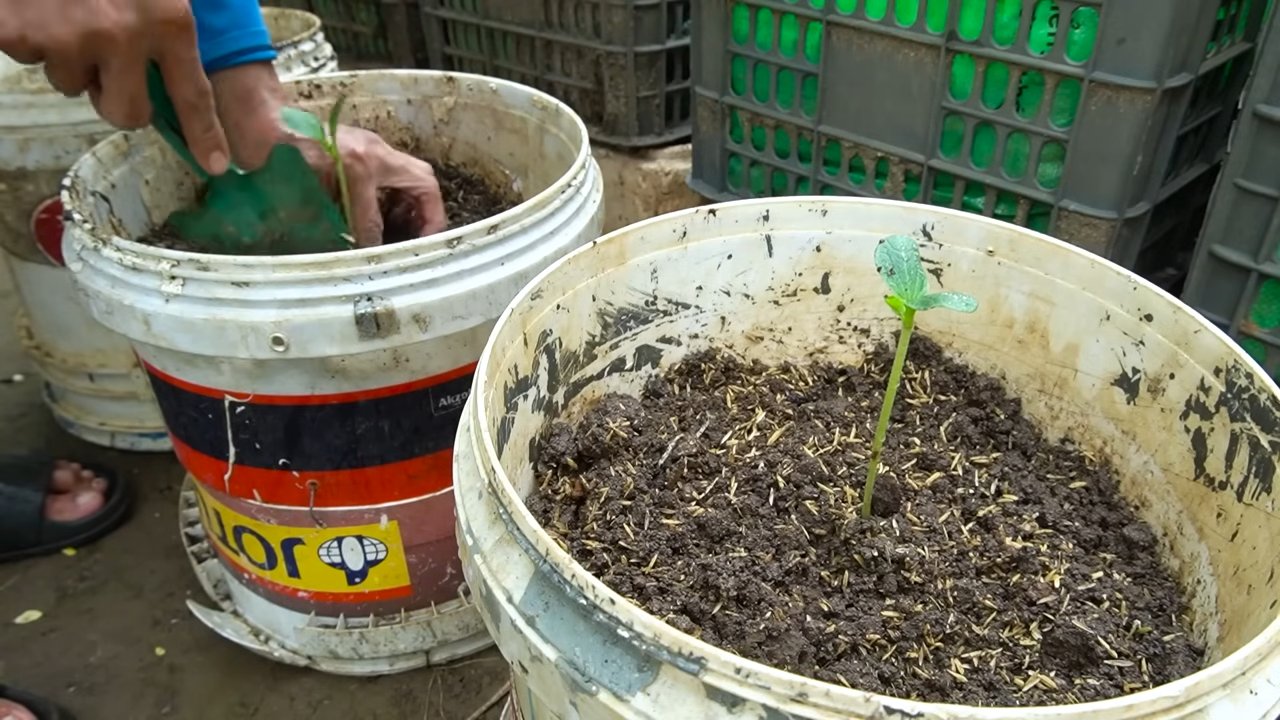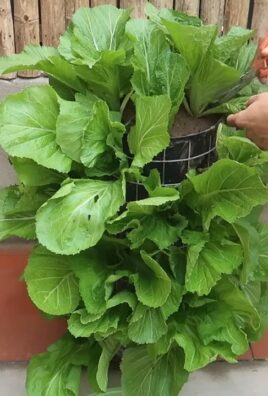Grow large zucchini at home? Absolutely! Imagine sinking your teeth into a juicy, homegrown zucchini so big it could feed the whole family. Forget those bland, watery supermarket versions – we’re talking about zucchini bursting with flavor and packed with nutrients, all thanks to your own green thumb. This isn’t just about growing vegetables; it’s about connecting with nature and enjoying the fruits (or rather, vegetables) of your labor.
For centuries, zucchini, a relative newcomer to the vegetable scene compared to its squash cousins, has been a staple in gardens worldwide. Originating in the Americas, it quickly spread across the globe, becoming a beloved ingredient in countless cuisines. From savory gratins to sweet zucchini bread, its versatility is unmatched. But let’s be honest, store-bought zucchini often lacks that vibrant taste and impressive size we crave.
That’s where these DIY tricks and hacks come in! I’m going to share some simple, yet effective, techniques that will help you grow large zucchini at home, even if you’re a beginner gardener. We’ll cover everything from soil preparation and watering techniques to pest control and harvesting tips. Why settle for small, underwhelming zucchini when you can have prize-winning specimens right in your backyard? Let’s get started and transform your garden into a zucchini paradise!

So züchtest du riesige Zucchinis zu Hause: Mein ultimativer Leitfaden
Hey Gartenfreunde! Habt ihr jemals davon geträumt, eine Zucchini zu ernten, die so groß ist, dass sie fast schon ein Möbelstück ist? Ich auch! Und ich habe herausgefunden, wie es geht. Es ist gar nicht so schwer, wie man denkt, aber es erfordert ein bisschen Planung, Geduld und die richtigen Techniken. In diesem Artikel teile ich meine bewährten Methoden, um Zucchinis anzubauen, die wirklich beeindrucken. Los geht’s!
Die Grundlagen: Vorbereitung ist alles
Bevor wir uns ins Detail stürzen, müssen wir sicherstellen, dass die Grundlagen stimmen. Eine gute Vorbereitung ist der Schlüssel zu jeder erfolgreichen Gartenarbeit, und das gilt besonders für riesige Zucchinis.
* Die richtige Sorte wählen: Nicht alle Zucchinis sind gleich. Einige Sorten sind einfach genetisch bedingt kleiner als andere. Für riesige Zucchinis empfehle ich Sorten wie ‘Black Beauty’, ‘Costata Romanesco’ oder ‘Fordhook’. Diese Sorten haben das Potenzial, wirklich groß zu werden, wenn man sie richtig pflegt.
* Der perfekte Standort: Zucchinis lieben die Sonne! Sie brauchen mindestens 6-8 Stunden direkte Sonneneinstrahlung pro Tag. Wählt also einen sonnigen Platz in eurem Garten. Außerdem brauchen sie viel Platz, besonders wenn ihr auf riesige Exemplare abzielt. Plant sie also nicht zu eng.
* Der Boden: Zucchinis sind Starkzehrer, das heißt, sie brauchen einen nährstoffreichen Boden. Bevor ihr pflanzt, solltet ihr den Boden mit Kompost, gut verrottetem Mist oder anderen organischen Materialien anreichern. Ein gut durchlässiger Boden ist ebenfalls wichtig, da Zucchinis keine Staunässe mögen.
Schritt-für-Schritt-Anleitung: Vom Samen zur Riesen-Zucchini
Jetzt, wo wir die Grundlagen geklärt haben, können wir uns dem eigentlichen Anbau widmen. Hier ist eine detaillierte Anleitung, die euch durch den gesamten Prozess führt:
1. Samen vorziehen (optional): Ihr könnt Zucchinis direkt ins Beet säen, aber ich ziehe es vor, sie vorzuziehen. Das gibt ihnen einen Vorsprung und schützt sie vor Schädlingen und schlechtem Wetter in den ersten Wochen.
* Füllt kleine Töpfe mit Anzuchterde.
* Legt 2-3 Samen pro Topf etwa 2 cm tief in die Erde.
* Gießt die Erde vorsichtig an und stellt die Töpfe an einen warmen, hellen Ort.
* Die Samen sollten innerhalb von 7-10 Tagen keimen.
* Sobald die Sämlinge ein paar Blätter haben, könnt ihr den stärksten Sämling pro Topf auswählen und die anderen entfernen.
2. Auspflanzen: Sobald die Frostgefahr vorüber ist und die Bodentemperatur mindestens 15°C beträgt, könnt ihr die Zucchini-Sämlinge ins Beet pflanzen.
* Hebt Löcher aus, die etwas größer sind als die Töpfe, in denen die Sämlinge gewachsen sind.
* Setzt die Sämlinge vorsichtig in die Löcher und füllt sie mit Erde auf.
* Gießt die Pflanzen gründlich an.
* Achtet darauf, dass die Pflanzen genügend Platz haben. Ich empfehle, sie mindestens 90 cm auseinander zu pflanzen.
3. Gießen: Zucchinis brauchen viel Wasser, besonders während der Fruchtbildung. Gießt sie regelmäßig, besonders bei trockenem Wetter.
* Gießt am besten früh am Morgen, damit die Blätter Zeit haben, zu trocknen, bevor die Sonne aufgeht. Das hilft, Pilzkrankheiten vorzubeugen.
* Gießt direkt an die Wurzeln und vermeidet es, die Blätter zu benetzen.
* Mulcht den Boden um die Pflanzen herum, um die Feuchtigkeit zu speichern und Unkraut zu unterdrücken.
4. Düngen: Wie bereits erwähnt, sind Zucchinis Starkzehrer. Düngt sie regelmäßig mit einem ausgewogenen Dünger oder einem Dünger, der speziell für Gemüse entwickelt wurde.
* Beginnt mit dem Düngen etwa 2 Wochen nach dem Auspflanzen.
* Folgt den Anweisungen auf der Düngemittelverpackung.
* Ich verwende gerne organische Düngemittel wie Komposttee oder verdünnte Fisch-Emulsion.
5. Bestäubung: Zucchinis haben männliche und weibliche Blüten. Die weiblichen Blüten haben einen kleinen Fruchtansatz direkt unter der Blüte, während die männlichen Blüten nur einen Stiel haben. Für die Fruchtbildung müssen die weiblichen Blüten bestäubt werden.
* Wenn ihr viele Bienen und andere bestäubende Insekten in eurem Garten habt, erledigen sie die Bestäubung wahrscheinlich von selbst.
* Wenn ihr jedoch nicht viele Insekten habt oder wenn ihr sicherstellen wollt, dass die Bestäubung erfolgreich ist, könnt ihr die Blüten von Hand bestäuben.
* Nehmt dazu einen kleinen Pinsel und sammelt Pollen von einer männlichen Blüte.
* Übertragt den Pollen dann auf die Narbe einer weiblichen Blüte.
* Die beste Zeit für die Bestäubung ist früh am Morgen.
6. Ausdünnen: Wenn ihr wirklich riesige Zucchinis wollt, solltet ihr die Anzahl der Früchte pro Pflanze begrenzen.
* Entfernt einige der kleineren Früchte, damit die Pflanze ihre Energie auf die verbleibenden Früchte konzentrieren kann.
* Ich lasse in der Regel nur 2-3 Früchte pro Pflanze wachsen, wenn ich auf riesige Exemplare abzielt.
7. Schutz vor Schädlingen und Krankheiten: Zucchinis können von verschiedenen Schädlingen und Krankheiten befallen werden.
* Achtet auf Anzeichen von Schädlingsbefall oder Krankheiten und handelt schnell.
* Häufige Schädlinge sind Blattläuse, Schnecken und Zucchini-Bohrer.
* Häufige Krankheiten sind Mehltau und Grauschimmel.
* Es gibt viele organische und chemische Mittel, um Schädlinge und Krankheiten zu bekämpfen. Ich bevorzuge organische Methoden, wann immer möglich.
8. Ernten: Zucchinis wachsen sehr schnell. Kontrolliert sie regelmäßig und erntet sie, wenn sie die gewünschte Größe erreicht haben.
* Für den normalen Verzehr erntet man Zucchinis, wenn sie etwa 15-20 cm lang sind.
* Für riesige Zucchinis lasst ihr sie einfach weiterwachsen.
* Schneidet die Zucchinis mit einem scharfen Messer oder einer Gartenschere vom Stiel ab.
* Seid vorsichtig, um die Pflanze nicht zu beschädigen.
Spezielle Tipps für Riesen-Zucchinis
Okay, jetzt kommen wir zu den wirklich wichtigen Dingen – den Geheimnissen, die eure Zucchinis von groß zu gigantisch machen!
* Regelmäßiges Gießen: Ich kann es nicht genug betonen: Zucchinis brauchen viel Wasser, besonders wenn sie groß werden. Stellt sicher, dass der Boden immer feucht ist, aber nicht durchnässt.
* Extra Dünger: Gebt euren Zucchinis einen zusätzlichen Schub mit einem Dünger, der reich an Kalium und Phosphor ist. Diese Nährstoffe fördern die Fruchtbildung und das Wachstum.
* Sonnenschutz: Wenn die Zucchinis sehr groß werden, können sie Sonnenbrand bekommen. Schützt sie vor direkter Sonneneinstrahlung, indem ihr sie mit einem Tuch oder einem Schirm abdeckt.
* Unterstützung: Riesige Zucchinis können sehr schwer werden. Stützt sie mit Brettern oder Kissen ab, damit sie nicht auf dem Boden liegen und faulen.
* Geduld: Das Wichtigste ist Geduld. Es braucht Zeit, bis eine Zucchini riesig wird. Gebt nicht auf und pflegt eure Pflanzen weiterhin gut.
Häufige Fehler vermeiden
Hier sind ein paar häufige Fehler, die ich bei anderen Gärtnern gesehen habe, und wie ihr sie vermeiden könnt:
* Zu wenig Platz: Zucchinis brauchen viel Platz, besonders wenn ihr auf riesige Exemplare abzielt. Plant sie nicht zu eng.
* Überwässerung: Obwohl Zucchinis viel Wasser brauchen, mögen sie keine Staunässe. Achtet darauf, dass der Boden gut durchlässig ist.

Conclusion
So, there you have it! Unlocking the secret to growing truly impressive, prize-winning zucchini right in your own backyard is more attainable than you might think. This DIY trick, focusing on strategic pruning and nutrient management, isn’t just about bragging rights; it’s about maximizing your yield, improving the overall health of your zucchini plants, and enjoying the unparalleled flavor of homegrown produce.
Think about it: no more watery, bland zucchini from the grocery store. Instead, imagine slicing into a firm, flavorful zucchini, bursting with freshness, that you nurtured from a tiny seed to a garden giant. The satisfaction alone is worth the effort. But beyond that, this method allows you to control exactly what goes into your plants, ensuring they are free from harmful chemicals and packed with the nutrients they need to thrive.
This isn’t a one-size-fits-all approach, of course. Feel free to experiment with different types of organic fertilizers to find what works best for your soil. Consider companion planting with beneficial herbs and flowers to attract pollinators and deter pests naturally. You could even try different pruning techniques, carefully observing how your plants respond. Perhaps you’ll discover a variation that works even better in your specific climate and garden conditions.
Remember, consistent watering is key, especially during those hot summer months. And don’t be afraid to hand-pollinate your zucchini flowers if you’re not seeing enough bee activity. A little extra attention can go a long way in ensuring a bountiful harvest.
We’ve shown you how to grow large zucchini, now it’s your turn to put these tips into action. Don’t be intimidated by the process; it’s surprisingly simple once you get the hang of it. Start with just a few plants and gradually expand your zucchini empire as you gain confidence.
We are incredibly excited to hear about your experiences! Did this DIY trick work for you? Did you discover any helpful variations? Share your photos, tips, and stories in the comments below. Let’s create a community of zucchini enthusiasts, all dedicated to growing the biggest and best zucchini possible. Happy gardening!
Frequently Asked Questions (FAQ)
What exactly is the DIY trick you’re referring to for growing large zucchini?
The core of the DIY trick involves a combination of strategic pruning and targeted nutrient management. Pruning focuses on removing excess leaves and male flowers to direct the plant’s energy towards fruit production. Nutrient management involves providing the zucchini plants with a balanced diet of essential nutrients, particularly phosphorus and potassium, which are crucial for fruit development. We recommend using organic fertilizers like bone meal and compost tea to achieve this.
How often should I prune my zucchini plants?
Pruning should be done gradually and consistently throughout the growing season. Start by removing any yellowing or damaged leaves near the base of the plant. As the plant grows, you can selectively remove some of the larger leaves that are shading the developing zucchini. Male flowers can be removed once you see plenty of female flowers developing. Aim to prune every week or two, depending on the growth rate of your plants.
What kind of fertilizer should I use to grow large zucchini?
Organic fertilizers are generally preferred for zucchini plants. Bone meal is an excellent source of phosphorus, which promotes strong root development and abundant fruit production. Compost tea provides a balanced blend of nutrients and beneficial microbes that improve soil health. You can also use fish emulsion or seaweed extract as a foliar spray to provide additional nutrients directly to the leaves. Avoid using fertilizers that are high in nitrogen, as this can promote excessive leaf growth at the expense of fruit production.
How do I know if my zucchini plants are getting enough water?
Zucchini plants need consistent moisture, especially during hot weather. The soil should be consistently moist but not waterlogged. Check the soil moisture by sticking your finger about an inch or two into the soil. If it feels dry, it’s time to water. Water deeply and thoroughly, ensuring that the water reaches the roots. Avoid watering the leaves, as this can promote fungal diseases. Mulching around the plants can help to retain moisture and suppress weeds.
My zucchini flowers are blooming, but I’m not getting any fruit. What’s going on?
This is a common problem, and it’s usually due to poor pollination. Zucchini plants have separate male and female flowers, and the pollen from the male flower must be transferred to the female flower for fertilization to occur. If there aren’t enough bees or other pollinators in your garden, you may need to hand-pollinate the flowers. To do this, simply use a small paintbrush to collect pollen from the male flower and then gently brush it onto the stigma of the female flower. The female flower can be identified by the small zucchini fruit at the base of the flower.
What are some common pests and diseases that affect zucchini plants, and how can I prevent them?
Common pests include squash bugs, squash vine borers, and aphids. Diseases include powdery mildew and blossom end rot. To prevent these problems, practice good garden hygiene by removing any dead or diseased leaves. Use insecticidal soap or neem oil to control pests. Ensure that your plants have good air circulation to prevent fungal diseases. Blossom end rot is caused by a calcium deficiency, so make sure your soil is rich in calcium or amend it with lime.
Can I grow zucchini in containers?
Yes, you can grow zucchini in containers, but you’ll need a large container (at least 24 inches in diameter) to accommodate the plant’s root system. Use a high-quality potting mix and make sure the container has good drainage. Water regularly and fertilize every two weeks. Choose a bush variety of zucchini, as these tend to be more compact and better suited for container growing.
How long does it take for zucchini to grow from seed to harvest?
Zucchini plants typically take about 50-60 days to mature from seed to harvest. You can start seeds indoors 2-3 weeks before the last frost or direct sow them in the garden after the danger of frost has passed. Harvest zucchini when they are young and tender, typically when they are about 6-8 inches long.
What are some creative ways to use large zucchini?
Large zucchini can be used in a variety of dishes. You can grate it and use it in zucchini bread, muffins, or fritters. You can slice it and grill it, bake it, or sauté it. You can also hollow it out and stuff it with rice, vegetables, or meat. Large zucchini can also be used to make zucchini noodles or zucchini boats. Get creative and experiment with different recipes!
What if I don’t have a garden? Can I still try this DIY trick?
While having a garden provides the ideal environment, you can still attempt this DIY trick with container gardening on a balcony or patio. Ensure the container is large enough, provides adequate drainage, and receives plenty of sunlight. You might need to hand-pollinate more frequently in a container setting. Even without a traditional garden, you can still grow large zucchini with a little extra care and attention.




Leave a Comment